Starting from:
$14.95
Home
World War II
World War II Chronologies: Army, Air Force, Navy, Military Intelligence Chronologies
World War II Chronologies: Army, Air Force, Navy, Military Intelligence Chronologies
World War II Chronologies: Army, Air Force, Navy, Military Intelligence Chronologies
5,227 pages constituting 12 sets of chronologies, produced from 1940 to 1991, providing day by day coverage of World War II.
Covers events in the United States, Africa, Eastern and Western Europe, the Middle East, Southeast Asia, the Far East, the Pacific, and the Western Hemisphere. Not only military events some chronologies also cover political, economic, and psychological events.
The collection contains a text transcript of all text embedded into the graphic image of each page of each document, creating a searchable finding aid. Text searches can be done across all chronologies in the collection.
This collection includes:
Military Intelligence Service, War Department Monthly Chronologies
2,965 pages of chronologies created during the war by the War Department's Military Intelligence Service. The MIS was responsible for the collection, evaluation, and determination of military information.
Reports for 23 different months: December 1941, March 1942, August 1942, October 1942, January 1943 - December 1943, June 1944 - December 1944.
United States Army Chronology: 1941-1945 (1989)
This 672 page compilation establishes the sequence of events in World War II from the time the first bombs fell on Pearl Harbor on 7 December 1941 until the surrender of the Japanese aboard the USS Missouri in Tokyo Bay on 2 September 1945. The volume details the tactical events of the war day by day, thus giving the reader a measure of the scope of global coalition warfare so that they can begin to grasp the relationship of the innumerable parts to the whole.
This volume emphasizes the ground actions of the U.S. Army in its various operations in Africa, Europe, the Middle East, Southeast Asia, the Far East, the Pacific, and the Western Hemisphere. Events are related at the appropriate level, including battalion and lesser units as well as regiment, division, corps, army, and army group. In addition, the combat actions of Army, Air, Navy, and Marine Corps units and of British, French, Soviet, and other Allied armed forces, as well as those of the enemy, are given in as much detail as space limitations allow. General events of historical import also appear in their proper places.
Abstract: “The value of this well-indexed book is twofold. In one volume the general reader and the student of military history have a ready reference to the whole war during that period in which the United States participated and can quickly check individual facts and dates. In addition, they are able to observe at a glance the progress of the combat operations on a global level for any given day or follow the progress of a single unit day by day to the conclusion of a specific campaign.
Geographically, events for the period from Pearl Harbor to the invasion of Normandy on 6 June 1944 are arranged in sequence from the Western Hemisphere westward around the world. From D Day to the end of the war the order is reversed, the action in western Europe taking precedence. Thus, the attack on Pearl Harbor is dated 7 December while the events occurring simultaneously in the Far East appear under 8 December. An exception has been made for the Gilberts and Marshalls campaign because the scene of engagement lies so near the International Date Line and also because most of the records consulted are dated west longitude.
To itemize the materials used in the preparation of this work of reference would be tedious, if not impossible. Suffice it to say that the compiler consulted extensively After Action Reports, histories of units engaged, dispatches of the Allied commanders, and other primary sources, but for correctness and completeness relied heavily on the findings of the historians who have written and are writing other volumes for the United States Army.”
United States Air Force Chronology (1991)
The U.S. Army Air Force in World War II: Chronology, 1941-1945, prepared by the U.S. Army's Office of the Chief of Military History.
This 743 page chronology is concerned primarily with operations of the US Army Air Forces and its combat units between December 7, 1941 and September 15, 1945. The research was a cooperative endeavor carried out in the United States Air Force historical archives by the Research Branch of the Albert F. Simpson Historical Research Center.
Abstract: “Such an effort has demanded certain changes in established historical methodology, as well as some arbitrary rules for presentation of the results. After International and US events, entries are arranged geographically. They begin with events at Army Air Forces Headquarters in Washington then proceed eastward around the world, using the location of the headquarters of the numbered air forces as the basis for placement. For this reason, entries concerning the Ninth Air Force while operating in the Middle East follow Twelfth Air Force. When that headquarters moves to England in October 1943, the entries are shifted to follow Eighth Air Force. The entries end with those numbered air forces which remained in the Zone of the Interior, as well as units originally activated in the Zone of the Interior, then designated for later movement overseas, such as Ninth and Tenth Air Forces. The Zone of the Interior entries do not include Eighth and Twentieth Air Forces, which were established in the Zone of the Interior with the original intent of placing them in those geographical locations with which they became historically identified. For these two units, original actions are shown either under AAF or in their intended geographic area of location.
All times and dates used are those of the area under discussion. The entry "1/2 Jun" indicates that an event occurred during the night between the two given dates, while "1-2 Jun" indicates an action over a period of time.
In dealing with people, again arbitrary decisions were implemented. For military men below the general officer or equivalent level, full grade and name were used. For general officers and those of equal grade in other US and foreign services, the complete rank (both that at the time first mentioned and the highest rank held prior to the end of the war) and name will be found in the index. Only an abbreviated rank (e.g., Gen or Adm) and last name are used in the text. The exception is where two general officers had the same last name; in such cases, the first name is also included. Similarly for civilian leaders, only the last name is used; full name and title are given in the index.
Location of all towns, islands, etc., is also made in the index. In all cases, attempts were made to cite place names in use by the native population at the time of or immediately before the war. No names imposed by a conqueror are used. For example Pylos Bay, not Navarino Bay, is used. Further, as appropriate, native geographic terms are used: Shima for island in. Japanese island groups, See for lake in Germany. However, two exceptions were made. In cases in which the place became infamous because of the actions of the conquering power, that name is preferred-for example Auschwitz would be used rather than the Polish name of Oswiecim. Also, in larger international cities, such as Roma, Koln and Wien, the anglicized name is used. Where a village or hamlet was difficult to locate or where there were several such places with the same name in a general area, the coordinates are given in the index. In some cases, with no extant navigational aids of the attacking force, the best possible guess was made based upon all available evidence. In other instances, such as the bridge at Hay-ti-attacked so often by Tenth Air Force-- a logical guess could not be made. In these cases, a question mark is placed in brackets after the index entry. Accent marks, such as umlauts, were omitted.”
United States Naval Chronology, World War II. Prepared in the Naval History Division, Office of the Chief of Naval Operations, Navy Dept. (1955)
Abstract: This U. S. Naval Chronology is intended to be precisely what the name implies. The Naval History Division has not attempted to prepare a chronology of all the far-flung operations of World War II. However, operations of the U. S. Army and of other navies are included as necessary in order to make the work complete for U. S. naval reference purposes.
The book is intended for general reference use. It will be noted that the purpose was to produce a brief factual chronological record of significant events. Comment is confined to less than ten brief notes which emphasize the importance of the critical and decisive naval actions of the war. It includes, also, a record of the loss or damage of every U. S. naval vessel of any size, as well as enemy ship sinkings by U. S. forces.
Events Leading Up to World War II. Chronological History of Certain Major International Events Leading Up to and During World War II with the Ostensible Reasons Advanced for Their Occurrence, 1931-1944. (1944)
Produced in 1944 by the Library of Congress
Abstract: The events leading up to the outbreak of the war and the subsequent American entry into it are of an importance and interest so great that it is difficult to exaggerate. The chronicle of the inexorable march of aggression after 1931 and the failure of efforts to curb it illuminate the problems of a secure peace in the future as no mere formal argument or debate could ever do. On the other hand, events since December 7, 1941, present a picture of increasingly cooperative effort on the part of those governments which look toward a civilized world at the war's conclusion. As a whole, the chronology was conceived as a working outline of the period and events covered.
Chronology of war in the Pacific for 7 December 1941 to 31 December 1943
Produced in June 1944 by the Navy Department, Headquarters of the Commander in Chief.
Abstract: This document is a chronology of the Pacific War. There were comparatively few officers in the Pacific Fleet who had been on duty in the Pacific since the beginning of the war, and the majority had been there less than a year. Many had been previously in locations and duties which precluded them from following the day by day progress of war in the Pacific very closely, and since arrival there, they had little spare time for delving into past history. The following chronology up to the end of 1943 is compiled for their benefit, as a possible aid to them in familiarizing themselves with previous events and in acquiring a broader conception of the Pacific War in its entirety. Many events of supreme importance to the participants, such as air-strikes, submarine operations, minor surface engagements, and the loss of planes, ships, and men, have had to be omitted for the sake of brevity. Such omission is in no way an under-rating of the event or the services performed.
Chronology of the Pacific War for 1944
Completed January 19, 1945 by the United States Fleet, Headquarters of the Commander in Chief, Navy Department.
This document provides a short chronology of the Pacific War from January through December 1944.
Chronology of War in the Pacific, 1 January to 2 September 1945
Completed in January 1946 by the Navy Department, Office of the Chief of Naval Operations. This document provides a short chronology of the Pacific War from January 1st through September 2nd, 1945.
Britain and World War II: A Chronology September 1939 — December 1940
Published in 1945 by the British Information Services Ministry of the British Government.
Trends in Russian Foreign Policy Since World War I: A Chronology of Events from March 15, 1917, to January 1, 1947
Prepared by the Legislative Reference Service of the Library of Congress in 1947
Abstract: As the title indicates the study is an objective presentation of selected events which individually and collectively throw light upon the development of Soviet policy during the past 30 years. These events naturally fall into the six following periods: (1) The period of isolation: 1917-21 (2) The period of rapprochement: 1921-32 (3) The period of cooperation: 1933-39 (4) The Soviet-German truce: 1939-41 (5) Russia in the war: 1941-45 (6) Postwar years: 1945-46
Important Military and Economic Events Chronology World War II
Produced by the U.S. Dept. of Labor, Bureau of Labor Statistics, in 1941, by its Historical Price Research Section. Covers July 26, 1939 to December 31, 1940.
Abstract: This chronology of the important events of the early period of the present war presents only such items as are considered significant from a general military or economic viewpoint. References to the evolution and extension of specific governmental controls over industry and to specific restrictions upon international trade have been excluded. Every reference in the chronology has been verified to official sources with the exception of events of such general importance as to justify reliance upon the metropolitan press.
Chronology of the War in the Southwest Pacific, 1941-1945
A memorial chronology produced by the Historical Division, G-3, GHQ, U.S. Army Forces, Pacific

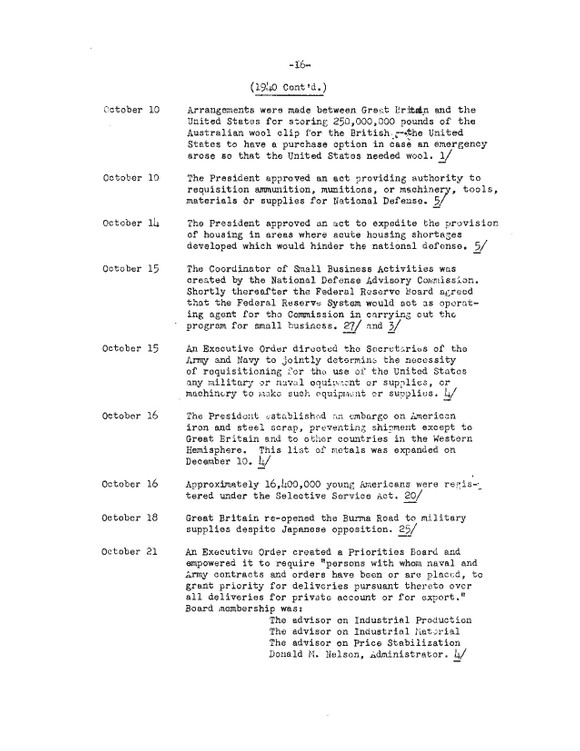

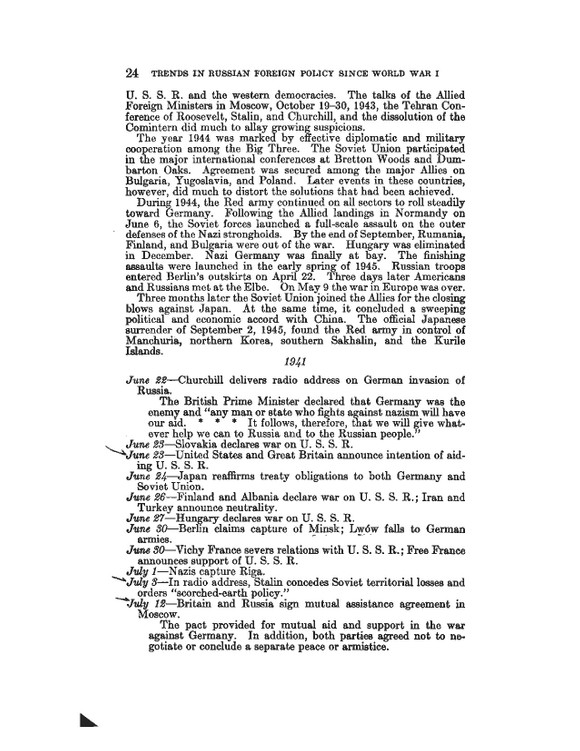

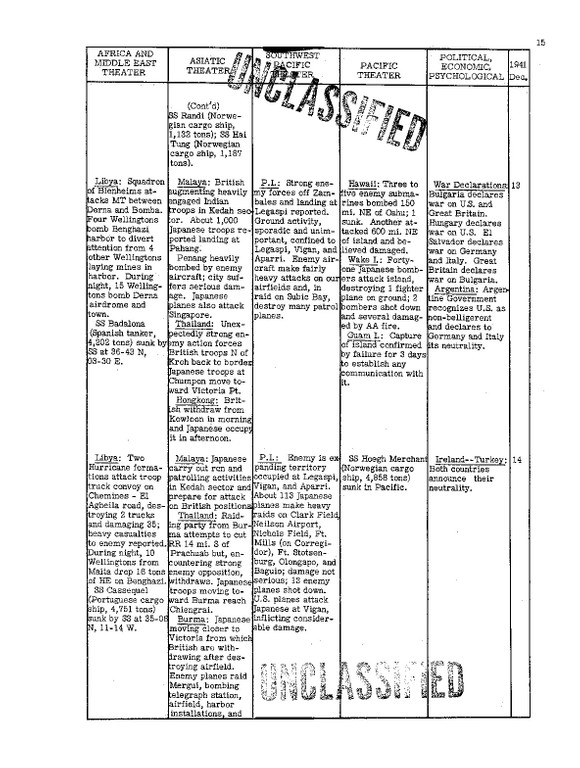
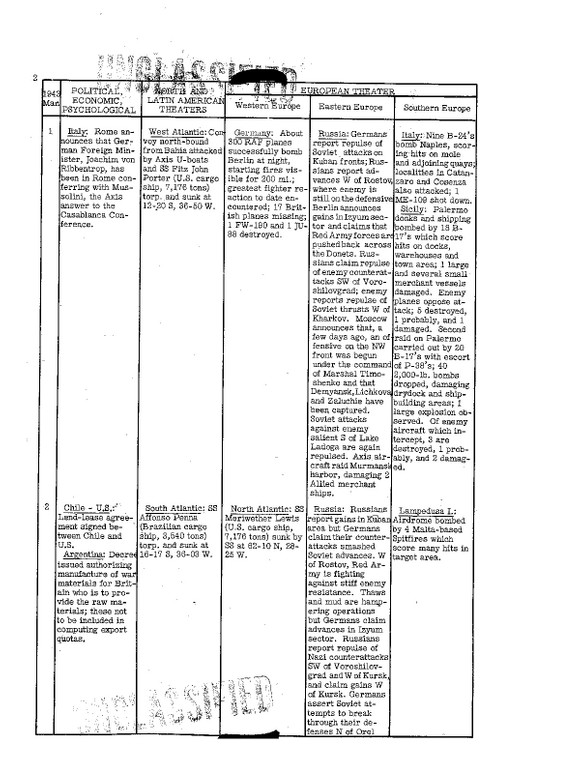
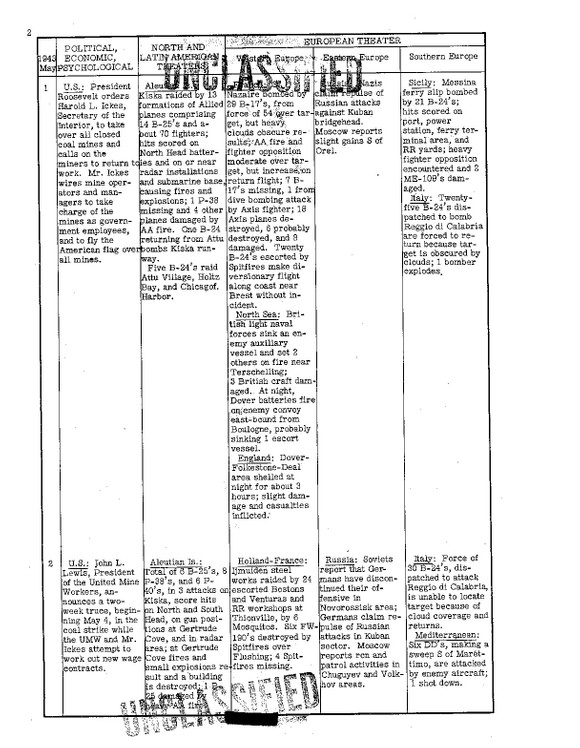
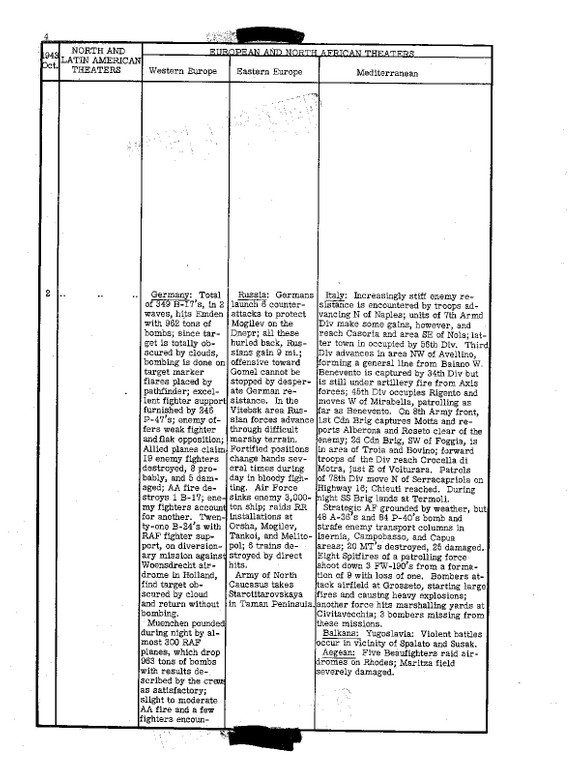
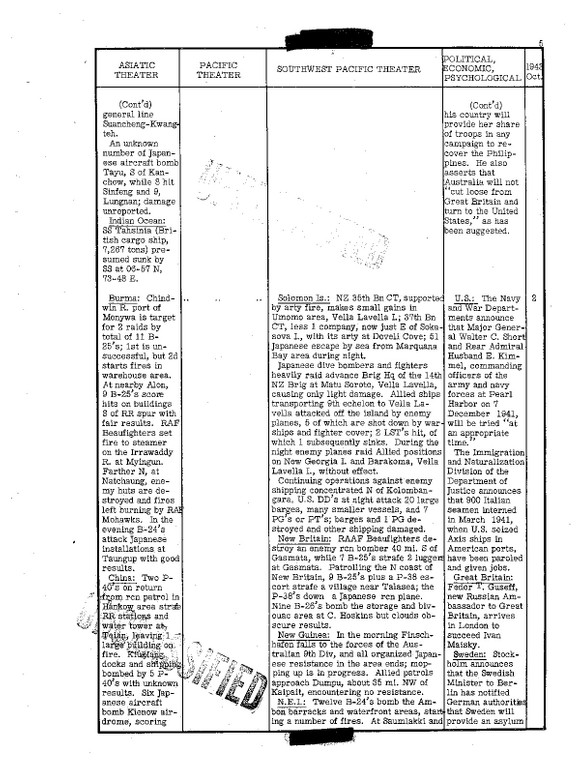


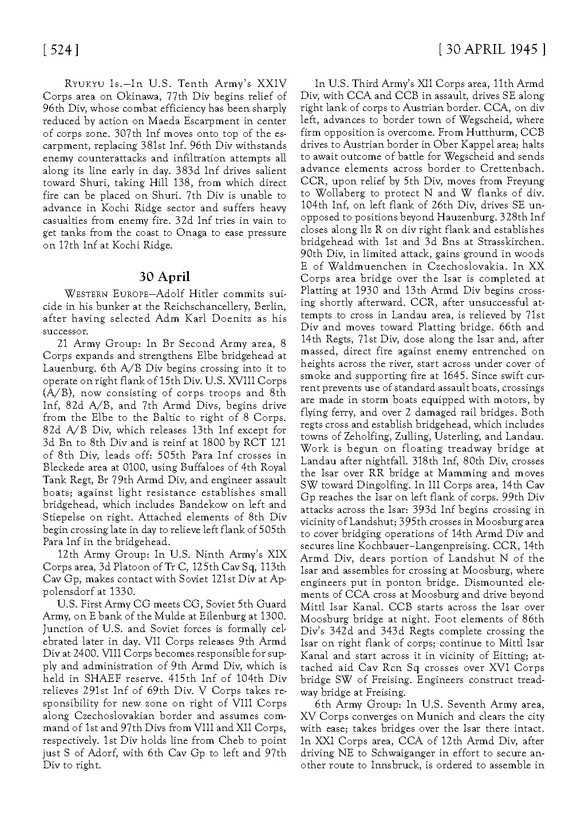

5,227 pages constituting 12 sets of chronologies, produced from 1940 to 1991, providing day by day coverage of World War II.
Covers events in the United States, Africa, Eastern and Western Europe, the Middle East, Southeast Asia, the Far East, the Pacific, and the Western Hemisphere. Not only military events some chronologies also cover political, economic, and psychological events.
The collection contains a text transcript of all text embedded into the graphic image of each page of each document, creating a searchable finding aid. Text searches can be done across all chronologies in the collection.
This collection includes:
Military Intelligence Service, War Department Monthly Chronologies
2,965 pages of chronologies created during the war by the War Department's Military Intelligence Service. The MIS was responsible for the collection, evaluation, and determination of military information.
Reports for 23 different months: December 1941, March 1942, August 1942, October 1942, January 1943 - December 1943, June 1944 - December 1944.
United States Army Chronology: 1941-1945 (1989)
This 672 page compilation establishes the sequence of events in World War II from the time the first bombs fell on Pearl Harbor on 7 December 1941 until the surrender of the Japanese aboard the USS Missouri in Tokyo Bay on 2 September 1945. The volume details the tactical events of the war day by day, thus giving the reader a measure of the scope of global coalition warfare so that they can begin to grasp the relationship of the innumerable parts to the whole.
This volume emphasizes the ground actions of the U.S. Army in its various operations in Africa, Europe, the Middle East, Southeast Asia, the Far East, the Pacific, and the Western Hemisphere. Events are related at the appropriate level, including battalion and lesser units as well as regiment, division, corps, army, and army group. In addition, the combat actions of Army, Air, Navy, and Marine Corps units and of British, French, Soviet, and other Allied armed forces, as well as those of the enemy, are given in as much detail as space limitations allow. General events of historical import also appear in their proper places.
Abstract: “The value of this well-indexed book is twofold. In one volume the general reader and the student of military history have a ready reference to the whole war during that period in which the United States participated and can quickly check individual facts and dates. In addition, they are able to observe at a glance the progress of the combat operations on a global level for any given day or follow the progress of a single unit day by day to the conclusion of a specific campaign.
Geographically, events for the period from Pearl Harbor to the invasion of Normandy on 6 June 1944 are arranged in sequence from the Western Hemisphere westward around the world. From D Day to the end of the war the order is reversed, the action in western Europe taking precedence. Thus, the attack on Pearl Harbor is dated 7 December while the events occurring simultaneously in the Far East appear under 8 December. An exception has been made for the Gilberts and Marshalls campaign because the scene of engagement lies so near the International Date Line and also because most of the records consulted are dated west longitude.
To itemize the materials used in the preparation of this work of reference would be tedious, if not impossible. Suffice it to say that the compiler consulted extensively After Action Reports, histories of units engaged, dispatches of the Allied commanders, and other primary sources, but for correctness and completeness relied heavily on the findings of the historians who have written and are writing other volumes for the United States Army.”
United States Air Force Chronology (1991)
The U.S. Army Air Force in World War II: Chronology, 1941-1945, prepared by the U.S. Army's Office of the Chief of Military History.
This 743 page chronology is concerned primarily with operations of the US Army Air Forces and its combat units between December 7, 1941 and September 15, 1945. The research was a cooperative endeavor carried out in the United States Air Force historical archives by the Research Branch of the Albert F. Simpson Historical Research Center.
Abstract: “Such an effort has demanded certain changes in established historical methodology, as well as some arbitrary rules for presentation of the results. After International and US events, entries are arranged geographically. They begin with events at Army Air Forces Headquarters in Washington then proceed eastward around the world, using the location of the headquarters of the numbered air forces as the basis for placement. For this reason, entries concerning the Ninth Air Force while operating in the Middle East follow Twelfth Air Force. When that headquarters moves to England in October 1943, the entries are shifted to follow Eighth Air Force. The entries end with those numbered air forces which remained in the Zone of the Interior, as well as units originally activated in the Zone of the Interior, then designated for later movement overseas, such as Ninth and Tenth Air Forces. The Zone of the Interior entries do not include Eighth and Twentieth Air Forces, which were established in the Zone of the Interior with the original intent of placing them in those geographical locations with which they became historically identified. For these two units, original actions are shown either under AAF or in their intended geographic area of location.
All times and dates used are those of the area under discussion. The entry "1/2 Jun" indicates that an event occurred during the night between the two given dates, while "1-2 Jun" indicates an action over a period of time.
In dealing with people, again arbitrary decisions were implemented. For military men below the general officer or equivalent level, full grade and name were used. For general officers and those of equal grade in other US and foreign services, the complete rank (both that at the time first mentioned and the highest rank held prior to the end of the war) and name will be found in the index. Only an abbreviated rank (e.g., Gen or Adm) and last name are used in the text. The exception is where two general officers had the same last name; in such cases, the first name is also included. Similarly for civilian leaders, only the last name is used; full name and title are given in the index.
Location of all towns, islands, etc., is also made in the index. In all cases, attempts were made to cite place names in use by the native population at the time of or immediately before the war. No names imposed by a conqueror are used. For example Pylos Bay, not Navarino Bay, is used. Further, as appropriate, native geographic terms are used: Shima for island in. Japanese island groups, See for lake in Germany. However, two exceptions were made. In cases in which the place became infamous because of the actions of the conquering power, that name is preferred-for example Auschwitz would be used rather than the Polish name of Oswiecim. Also, in larger international cities, such as Roma, Koln and Wien, the anglicized name is used. Where a village or hamlet was difficult to locate or where there were several such places with the same name in a general area, the coordinates are given in the index. In some cases, with no extant navigational aids of the attacking force, the best possible guess was made based upon all available evidence. In other instances, such as the bridge at Hay-ti-attacked so often by Tenth Air Force-- a logical guess could not be made. In these cases, a question mark is placed in brackets after the index entry. Accent marks, such as umlauts, were omitted.”
United States Naval Chronology, World War II. Prepared in the Naval History Division, Office of the Chief of Naval Operations, Navy Dept. (1955)
Abstract: This U. S. Naval Chronology is intended to be precisely what the name implies. The Naval History Division has not attempted to prepare a chronology of all the far-flung operations of World War II. However, operations of the U. S. Army and of other navies are included as necessary in order to make the work complete for U. S. naval reference purposes.
The book is intended for general reference use. It will be noted that the purpose was to produce a brief factual chronological record of significant events. Comment is confined to less than ten brief notes which emphasize the importance of the critical and decisive naval actions of the war. It includes, also, a record of the loss or damage of every U. S. naval vessel of any size, as well as enemy ship sinkings by U. S. forces.
Events Leading Up to World War II. Chronological History of Certain Major International Events Leading Up to and During World War II with the Ostensible Reasons Advanced for Their Occurrence, 1931-1944. (1944)
Produced in 1944 by the Library of Congress
Abstract: The events leading up to the outbreak of the war and the subsequent American entry into it are of an importance and interest so great that it is difficult to exaggerate. The chronicle of the inexorable march of aggression after 1931 and the failure of efforts to curb it illuminate the problems of a secure peace in the future as no mere formal argument or debate could ever do. On the other hand, events since December 7, 1941, present a picture of increasingly cooperative effort on the part of those governments which look toward a civilized world at the war's conclusion. As a whole, the chronology was conceived as a working outline of the period and events covered.
Chronology of war in the Pacific for 7 December 1941 to 31 December 1943
Produced in June 1944 by the Navy Department, Headquarters of the Commander in Chief.
Abstract: This document is a chronology of the Pacific War. There were comparatively few officers in the Pacific Fleet who had been on duty in the Pacific since the beginning of the war, and the majority had been there less than a year. Many had been previously in locations and duties which precluded them from following the day by day progress of war in the Pacific very closely, and since arrival there, they had little spare time for delving into past history. The following chronology up to the end of 1943 is compiled for their benefit, as a possible aid to them in familiarizing themselves with previous events and in acquiring a broader conception of the Pacific War in its entirety. Many events of supreme importance to the participants, such as air-strikes, submarine operations, minor surface engagements, and the loss of planes, ships, and men, have had to be omitted for the sake of brevity. Such omission is in no way an under-rating of the event or the services performed.
Chronology of the Pacific War for 1944
Completed January 19, 1945 by the United States Fleet, Headquarters of the Commander in Chief, Navy Department.
This document provides a short chronology of the Pacific War from January through December 1944.
Chronology of War in the Pacific, 1 January to 2 September 1945
Completed in January 1946 by the Navy Department, Office of the Chief of Naval Operations. This document provides a short chronology of the Pacific War from January 1st through September 2nd, 1945.
Britain and World War II: A Chronology September 1939 — December 1940
Published in 1945 by the British Information Services Ministry of the British Government.
Trends in Russian Foreign Policy Since World War I: A Chronology of Events from March 15, 1917, to January 1, 1947
Prepared by the Legislative Reference Service of the Library of Congress in 1947
Abstract: As the title indicates the study is an objective presentation of selected events which individually and collectively throw light upon the development of Soviet policy during the past 30 years. These events naturally fall into the six following periods: (1) The period of isolation: 1917-21 (2) The period of rapprochement: 1921-32 (3) The period of cooperation: 1933-39 (4) The Soviet-German truce: 1939-41 (5) Russia in the war: 1941-45 (6) Postwar years: 1945-46
Important Military and Economic Events Chronology World War II
Produced by the U.S. Dept. of Labor, Bureau of Labor Statistics, in 1941, by its Historical Price Research Section. Covers July 26, 1939 to December 31, 1940.
Abstract: This chronology of the important events of the early period of the present war presents only such items as are considered significant from a general military or economic viewpoint. References to the evolution and extension of specific governmental controls over industry and to specific restrictions upon international trade have been excluded. Every reference in the chronology has been verified to official sources with the exception of events of such general importance as to justify reliance upon the metropolitan press.
Chronology of the War in the Southwest Pacific, 1941-1945
A memorial chronology produced by the Historical Division, G-3, GHQ, U.S. Army Forces, Pacific














1 file (361.0MB)



